
Matthew O’Toole
Imaging the World One Photon at a Time
The core component of any modern camera is its digital sensor, which forms images by collecting billions of photons traveling through the physical world and through the lens of a camera every second. While the sensors used in cellphones or professional DSLR cameras are designed to aggregate as many photons as possible, a new type of sensor, known as a single-photon avalanche diode (SPAD), is designed to detect and timestamp individual photon events. Through the co-design of computational algorithms and hardware systems, I will talk about how SPADs enable new imaging feats, including the ability to (1) image the propagation of light through a scene at trillions of frames per second, (2) form dense 3D measurements from extremely low photon counts, and (3) reconstruct the shape and reflectance of objects hidden from view.
Matthew O’Toole is an Assistant Professor with the Robotics Institute and Computer Science Department at Carnegie Mellon University. His research focuses on computational imaging, a highly multi-disciplinary topic that uses novel combinations of computation, electronics, and optics to overcome the limitations of conventional imaging systems. He was a Banting Postdoctoral Fellow with the Department of Electrical Engineering at Stanford University. Prior to that, he completed his Ph.D. at the University of Toronto with the Department of Computer Science, where his thesis received the ACM SIGGRAPH Outstanding Dissertation Honorable Mention award. His work also received two runner-up best paper awards (CVPR 2014, ICCV 2007) and two best demo awards (CVPR 2015, ICCP 2015).